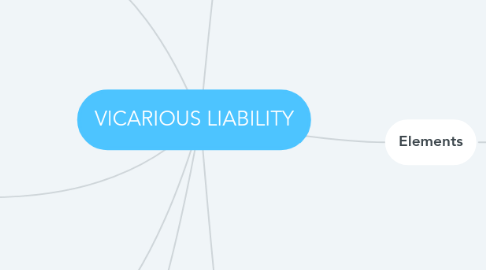
1. Negligent and careless acts:
1.1. The employer will not be liable if the employee is careless in doing something that he is not employed to do
1.1.1. Century Insurance Co Ltd v Northern Ireland Road Transport Board: The court held the defendant (employer) vicariously liable for the act of his employee throwing a burning match onto the ground and causing the plaintiff’s property to be destroyed in the course of his employment as it was an unauthorized manner of performing his task of delivering petrol.
1.1.2. Ilkiw v Samuels: The court held the defendant vicariously liable for the injury of the third party that arose from the employee’s negligent conduct as a driver within the course of his employment in allowing the third party to drive the lorry.
2. Frolics and detours:
2.1. Acts done not for the employer’s benefit or for the employee’s own personal benefit is considered as a frolic and detour.
2.1.1. If an employee engages in a task for his own personal benefit, the employer will not be vicariously liable for any tort committed during such period as it is outside the course of employment.
2.1.2. Storey v Ashton: The court held the defendant not vicariously liable for the plaintiff’s injury as the tort arose from the act of the employee taking a detour to run his own errands when he should have been delivering wine from a cart.
3. Prohibitions by employer:
3.1. An act may be within the employee’s course of employment even though it has been expressly forbidden by the employer. For it to be so:
3.1.1. The act must be related to the employee’s job
3.1.2. The act must be done for the benefit of the employer
4. Defences
4.1. Contributory negligence
4.2. Volenti non fit injuria
5. Definition
5.1. A situation where an employer is responsible for damages caused by the torts of his employees to a third party while acting in their course of employment.
6. Elements
6.1. The tortfeasor must be an employee of the master (employer
6.1.1. Employer: somebody who has the right to hire and fire. - It must be determined that a person is an employee and not an independent contractor. - “Full time” indicates that a person is an employee.
6.1.2. There are three tests to help determine who an employee is:
6.1.2.1. Control test
6.1.2.1.1. The test was laid down in Short v J & W Henderson where Lord Thankerton listed the four factors to be considered: i) Power of selection by the employer ii) Power in determining salary or other remuneration iii) Power of right of the employer to control the method in which the work was done iv) Power and right of the employer to terminate the employee’s services
6.1.2.1.2. The degree of control exercised over a person’s work by the employer is looked into. - Where the employer had control over the work and was in such a position to determine how, what, and when tasks should be done. - E.g: Helpful in determining whether a factory worker is an employer.
6.1.2.1.3. If a person is engaged to do a particular work, but has discretionary power on how, what, and when a task is to be done, such person is an independent contractor. - Thus, vicarious liability does not apply
6.1.2.2. Business integration or Organisation test
6.1.2.2.1. The test was established in Stevenson, Jordan & Harrison v MacDonald Evans where a distinction between a contract for service and contract of service was made.
6.1.2.2.2. A person in a contract of service: employee - A person is employed as part of the business and his work forms an integral part of it.
6.1.2.2.3. A person in a contract for service: independent contractor - Although work is done for the business, it is not integrated into it, but is only accessory to it.
6.1.2.3. Multiple test
6.1.2.3.1. The test was established in Ready Mixed Concrete Ltd v Minister of Pensions & National Insurance where three factors need to be fulfilled in order for there to be a contract of service
6.1.3. Special rules:
6.1.3.1. Health authorities
6.1.3.1.1. - Nurses, radiographers, house-surgeons, and assistant medical officers are employees of the hospital for purposes of vicarious liability.
6.1.3.2. Borrowed employees
6.1.3.2.1. The principle as laid down in Mersey Docks & Harbour Board v Coggins & Griggiths (Liverpool) Ltd is: - If B, an employee of A, is lent to C, and B subsequently commits a tort, A will be vicariously liable for the tort committed, unless A has stripped himself of all possession and control
6.2. The employee must have committed a tort
6.2.1. In Imperial Chemical Industries v Shatwell, it was established that for an employer to be vicariously liable, a tort must have been committed by the employee and all the elements of the particular tort must be satisfied.
6.3. The tort must have been committed in the course of employment
6.3.1. Acting in the course of employment: i) The act is a wrongful act authorized by the employer ii) It is an unauthorized manner of doing something which is authorized
7. Employer’s Indemnity
7.1. An employer has a right to claim indemnity for the loss attributable to the employee’s breach of contract
7.1.1. Sec. 10, CLA 1956: permits contribution from an employee who is or would, if sued, have been liable in respect of the same damage, whether as a joint tortfeasor or otherwise.
7.1.2. Lister v Romford: The plaintiff suffered injuries from the negligent conduct of an employee to which the bus company was vicariously liable for, and therefore the plaintiff claimed compensation from the bus company, who then claimed indemnity from the employee.

